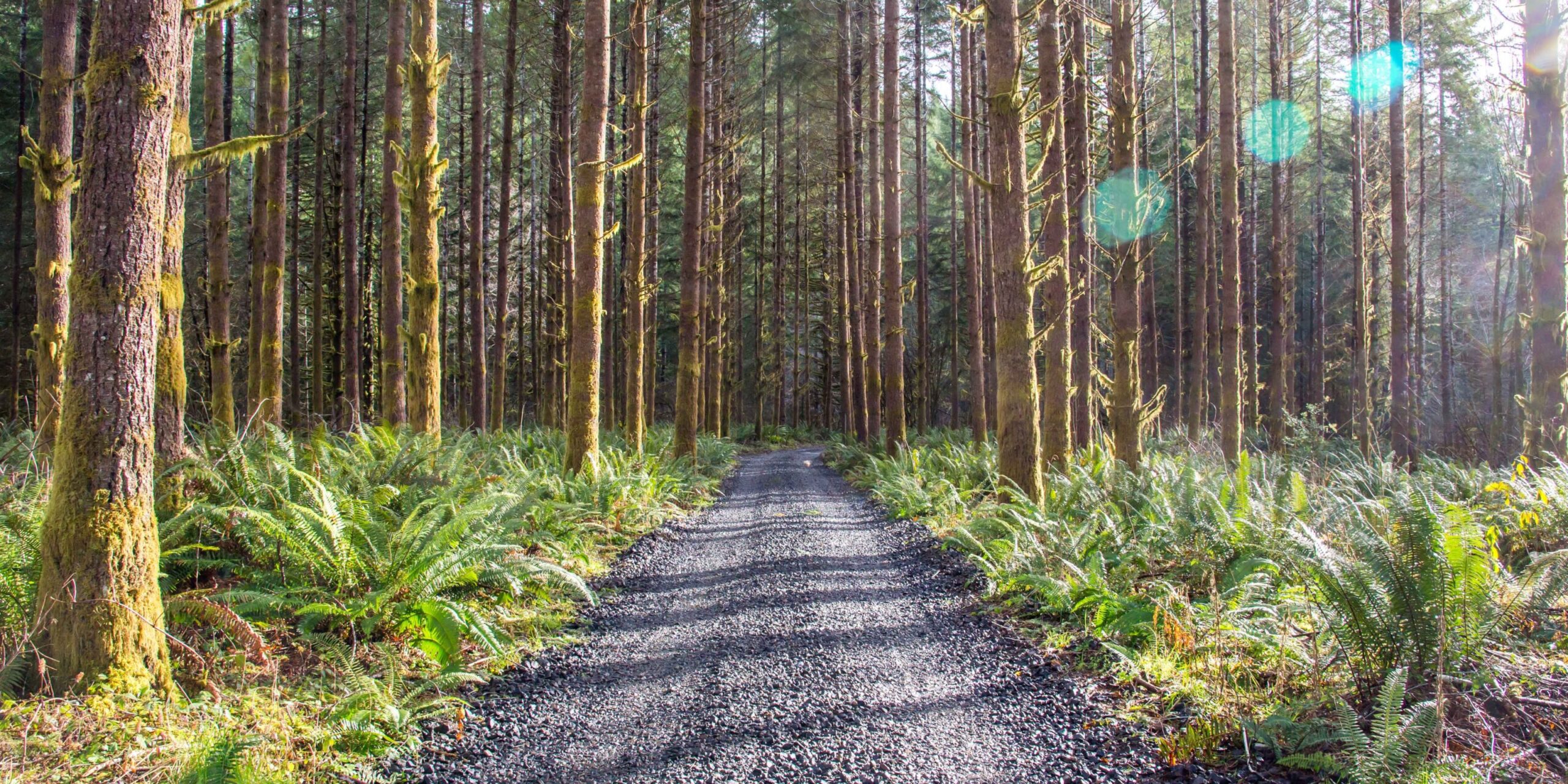
Work. Play. Renew.
7 More Native Trees You’ll Find in Oregon’s Forests
Did you know that forests cover more than 30.5 million acres of land in Oregon? That’s more than half the state! If you are looking to visit beautiful forests and see abundant trees, everything you’re looking for can be found in Oregon’s forests.
We know a thing or two about the forests and trees at Oregon Forests Forever. We are a group of individuals, organizations and businesses working together for active and sustainable management of the forests in our state. We’ve already shared five types of trees for which Oregon is known for, now learn even more native trees that you’ll find in Oregon’s forests.
1. Red Alder (Alnus rubra)
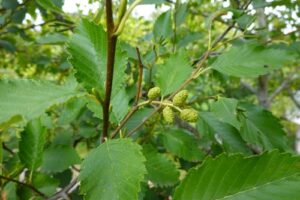
Red alder trees, sometimes called Oregon alders, are deciduous trees, meaning they shed their leaves annually. The name comes from the red dye made from their bark and the color of the wood when it’s cut. They are fast-growing trees and can reach heights of 40 to 80 feet high. Compared to other trees, they have a relatively short life span, as they frequently don’t survive more than 100 years. They are low maintenance if you happen to grow them in your yard.
Red alder trees are primarily found along stream banks and in moist woods. Lots of birds eat the seeds that come from these trees, including the common redpoll and pine siskin.
2. Pacific Dogwood (Cornus nuttallii)
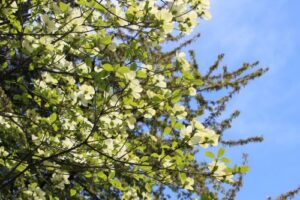
Pacific dogwood trees, also known as western flowering dogwoods, are attractive trees. They have large white bracts that people commonly mistake for petals. These bracts are paired with deep green oval-shaped leaves and are sure to catch your eye. Typically, these trees are on the shorter side, growing from 20 to 30 feet tall, but some reach heights of up to 90 feet.
Pacific dogwood trees tend to grow below taller trees in forests that are open and mixed. They’re found in moist areas that have well-drained and acidic soil. Birds like woodpeckers and white-crowned sparrows use these trees as a food source and a home.
3. Willamette Valley Ponderosa Pine (Pinus ponderosa var. benthamiana)
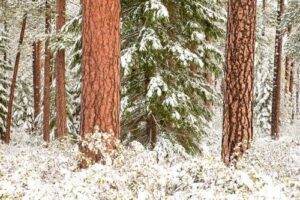
Don’t confuse the Willamette Valley ponderosa pine with the ponderosa pine that’s found on the east side of the Cascade Mountains, as they’re genetically different. Willamette Valley ponderosa pine trees are attractive large evergreen trees that can reach heights of 150 feet or more. They have deep-green-colored needles that form in clusters of three and are six to 10 inches long. They also grow large brown cones that give off a vanilla scent.
Willamette Valley ponderosa pine trees are drought-resistant and grow better in soils that are well-drained. Birds like the slender-billed nuthatch and Lewis’s woodpecker rely on these trees as their food source.
4. Vine Maple (Acer circinatum)
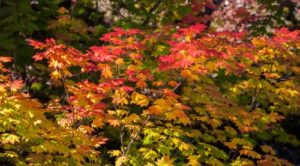
The name of vine maple trees is misleading, as it’s not technically a vine. However, they do have extremely slender branches that are often sprawling, which is how they earned their name. These trees grow to about 21 feet high, about 20 feet wide and can live to 90 years old. During the spring, vine maple trees grow red and white flowers. In the fall, they change to red, orange and yellow.
Vine maples are mostly found in moist or wet areas. They tend to grow in the shade of other, larger trees, but they also grow well in an area that’s sunny if there’s enough moisture. Birds, squirrels and chipmunks use the seeds from these trees as a food source.
5. Oregon Crabapple (Malus fusca)
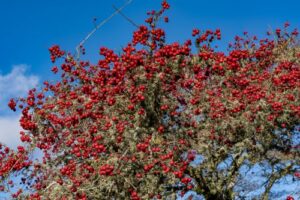
Not only are Oregon crabapple trees found in Oregon forests, but they’re also a popular choice for yards too. Sometimes called Pacific crabapples, they are slow-growing trees, reaching a maximum height of about 36 feet. Oregon crabapple trees grow fragrant blossoms in white and pink shades, with the leaves turning yellow-orange or red during the fall months. Their fragrance attracts birds like cedar waxwings and finches.
Oregon crabapple trees grow well at the edges of wetlands and in moist woods. They’re able to tolerate soil that’s heavy clay.
6. Bitter Cherry (Prunus emarginata)
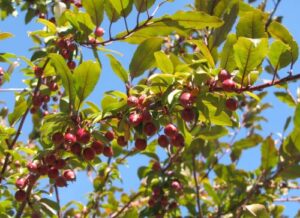
As the name suggests, bitter cherry trees grow red fruits. However, these fruits are not palatable to humans. They do, however, attract wildlife such as slugs, birds and small mammals. Bitter cherry trees are deciduous and easy to grow. They can reach heights of 30 feet tall and only live about 30 to 40 years. In the spring, white flowers grow on them. These trees are also sometimes referred to as Oregon cherry trees.
Bitter cherry trees are often found growing along streams, as they prefer areas that are moist and sunny.
7. Pacific Madrone (Arbutus menziesii)
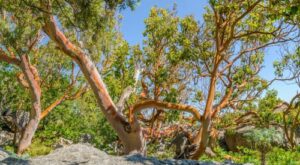
Pacific madrone trees are native to the West Coast but have been on the decline in the Pacific Northwest. They are attractive trees with orange-red bark and oval-shaped leaves that are glossy dark and green — In the spring months, they grow cream-colored flowers. The Pacific madrone can reach heights of 100 feet and live for over 250 years.
Pacific madrone trees are typically found on bluffs sitting above the seashore, on sites that are dry, well-drained and sunny. They’re not tolerant of site disturbances and shed a lot of debris.
There are so many native trees to discover in Oregon forests. If you live in the area, we encourage you to take a trip to an Oregon forest. If you are looking to visit Oregon, we encourage you to visit the beautiful forests we have here.
We want you to see the beauty of the native Oregon trees for yourself. Once you do, we know you will fall in love with Oregon forests as much as we have here at Oregon Forests Forever. Join us to stay up to date on the latest forest news.